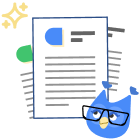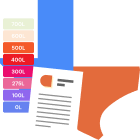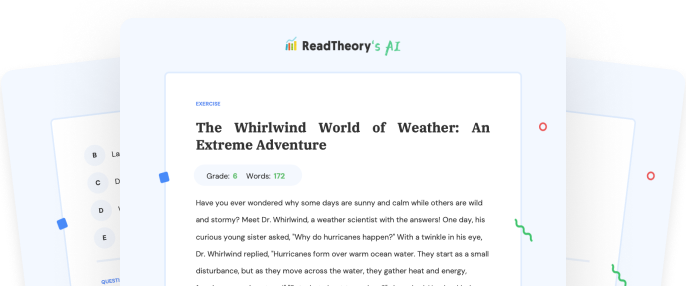Transform Your Teaching
with AI-Powered Worksheets
With ReadTheory’s Instant Worksheet Builder, you can create engaging, grade-appropriate worksheets tailored to your students in minutes. Spark curiosity, save time, and empower critical thinking with AI-powered tools designed for teachers like you.


A Giant Leap: The Story of the Moon Landing
On July 20, 1969, mankind achieved what once seemed impossible - landing on the moon. The Apollo 11 mission, led by astronauts Neil Armstrong, Michael Collins, and Buzz Aldrin, marked a monumental moment in human history. As Armstrong descended from the lunar module named 'Eagle,' he uttered the iconic phrase, 'That's one small step for man, one giant leap for mankind.' The mission was a product of years of preparation and technological advancements. It took the astronauts four days to travel the roughly 238,855 miles to the moon, a celestial body that is about one-quarter the size of Earth. The moon's gravity is one-sixth of Earth's, making every step a bounce. Armstrong and Aldrin spent over two hours outside the module collecting samples, conducting experiments, and taking photos before returning to Earth. Their journey back was as daunting as the trip to the moon, re-entering Earth's atmosphere at a speed of 25,000 miles per hour. The success of the Apollo 11 mission sparked a new era of space exploration, inspiring generations to reach for the stars.
Question 1
What was the iconic phrase uttered by Neil Armstrong as he descended from the lunar module?
That's one small step for man, one giant leap for mankind.
Fly me to the moon.
The Eagle has landed.
To infinity and beyond.
In space, no one can hear you scream.
Question 2
How long did it take for the Apollo 11 astronauts to travel to the moon?
Four days
One week
Three days
Two days
Six days
Question 3
What effect does the moon's gravity have on movement?
It makes every step a bounce
It makes you feel heavier
It makes you move slower
It makes you move faster
It doesn't affect movement
Question 4
What was the speed of re-entry into Earth's atmosphere for the Apollo 11 mission?
25,000 miles per hour
20,000 miles per hour
15,000 miles per hour
30,000 miles per hour
10,000 miles per hour
Question 5
What was the name of the lunar module in the Apollo 11 mission?
Eagle
Hawk
Falcon
Dove
Sparrow
 or share via
or share via

Assign the ReadTheory pretest to determine students' reading levels.

Why Teachers Love
Instant Worksheet Builder?

Tailored Content for Every Student
Craft worksheets with passages and multiple-choice questions customized to your chosen topic and grade level, ensuring relevance and engagement.

Save Hours
of Prep Time
Our AI, Lexi, generates complete worksheets—passages, questions, and answers—in minutes, freeing you to focus on teaching, not planning.

Standards-Aligned Learning
Every worksheet is designed to boost reading comprehension and critical thinking, aligning seamlessly with State Standards to help your students shine.
Personalized teaching
for personalized learning
Browse worksheets created and refined by educators using Lexi—your source for inspiration and ready-to-use resources.


ReadTheory is free for Teachers to use.
Join thousands of educators using ReadTheory for free. Sign up today and start creating in just minutes!





